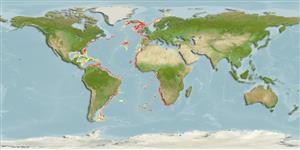Common names from other countries
Environment: milieu / climate zone / depth range / distribution range
Écologie
; profondeur 400 - 1230 m (Ref. 97531). Tropical
Distribution
Pays | Zones FAO | Écosystèmes | Occurrences | Introductions
Eastern Atlantic: from southwest Sahara to Namibia.
Length at first maturity / Taille / Poids / Âge
Maturity: Lm ? range ? - ? cm Max length : 16.7 cm TL mâle / non sexé; (Ref. 434)
Benthic or benthopelagic (Ref. 97531). Inhabits waters over muddy sand bottoms of the continental slope at depths from 500 to 1100 m. Carnivorous (Ref. 434).
Life cycle and mating behavior
Maturité | Reproduction | Frai | Œufs | Fécondité | Larves
Members of the order Decapoda are mostly gonochoric. Mating behavior: Precopulatory courtship ritual is common (through olfactory and tactile cues); usually indirect sperm transfer.
Fischer, W., G. Bianchi and W.B. Scott (eds.). 1981. (Ref. 434)
Statut dans la liste rouge de l'IUCN (Ref. 130435)
statut CITES (Ref. 108899)
Not Evaluated
Not Evaluated
Utilisations par l'homme
| FishSource |
Outils
Plus d'informations
Taille/ÂgeCroissanceLongueur-poidsLongueur-longueurMorphologieLarvesAbondance
Sources Internet
Estimates based on models
Preferred temperature
(Ref.
115969): 4.3 - 7.3, mean 5.8 (based on 34 cells).
Vulnérabilité
Low vulnerability (10 of 100).
Catégorie de prix
Unknown.
